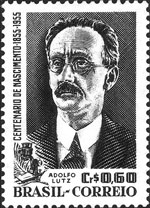Volume 27, Number 9—September 2021
Etymologia
Paracoccidioides
Paracoccidioides [p′a ɾə kok-sidʺe-oiʹ d′ez]
From the Greek (para/παρά + kokkis [coccidia]), Adolpho Lutz (Figure 1) described Paracoccidioides in 1908. After analysis of oral and cervical lymph node lesions from infected patients, Lutz initially believed that he had detected Coccidioides. However, more extensive analysis showed that he had detected another fungus. Because of morphologic and clinical disease similarities, the name Paracoccidioides was suggested. The prefix para (near) indicates its similarity with Coccidioides.
Paracoccidioides is a thermally dimorphic fungus (Figure 2). It grows as an infective mycelium form (at 18°C–23°C) or a parasitic multibudding yeast form (at 35°C–37°C). It is composed of 2 species: P. brasiliensis and P. lutzi. They are the etiologic agents of paracoccidioidomycosis. This systemic infection is endemic to Latin America (southern Mexico to northern Argentina). The highest number of cases are found in Brazil, Colombia, and Venezuela. Paracoccidioides conidia and mycelia are found in soil and transmitted by inhalation.
References
- Bocca AL, Amaral AC, Teixeira MM, Sato PK, Shikanai-Yasuda MA, Soares Felipe MS. Paracoccidioidomycosis: eco-epidemiology, taxonomy and clinical and therapeutic issues. Future Microbiol. 2013;8:1177–91. DOIPubMedGoogle Scholar
- Chaves AFA, Navarro MV, de Barros YN, Silva RS, Xander P, Batista WL. Updates in Paracoccidioides biology and genetic advances in fungus manipulation. J Fungi (Basel). 2021;7:116. DOIPubMedGoogle Scholar
- Lutz A. A pseudococcidic mycose located in the mouth and observed in Brazil: contribution to the knowledge of American hypoblatomycoses [in Portuguese]. Revista Semanal de Medicina e Cirurgia. 1908;22:121–4.
- Turland NJ, Wiersema JH, Barrie FR, Greuter W, Hawksworth DL, Herendeen PS, et al., editors. International code of nomenclature for algae, fungi, and plants (Shenzhen code) adopted by the Nineteenth International Botanical Congress Shenzhen, China, July 2017. Regnum Vegetabile 159. Glashütten (Germany): Koeltz Botanical Books; 2018 [cited 2021 May 17]. https://www.iapt-taxon.org/nomen/pages/intro/citation.html
- Viera e Silva CR, de Mattos MC, Fujimore K. Scanning electron microscopy of Paracoccidioides brasiliensis. Study with and without pre-treatment with pooled sera from patients with ‘South American blastomycosis’. Mycopathol Mycol Appl. 1974;54:235–51.PubMedGoogle Scholar
Figures
Cite This ArticleOriginal Publication Date: August 19, 2021
Related Links
Table of Contents – Volume 27, Number 9—September 2021
| EID Search Options |
|---|
|
|
|
|
|
|


Please use the form below to submit correspondence to the authors or contact them at the following address:
Lucas Nojosa Oliveira, Faculdade Estácio de Sá de Goiás, Avenida Goiás 2151, Setor Central, Goiânia, Goiás, CEP 74063-010, Brazil
Top